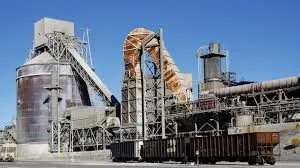Cement is the backbone of modern construction, from skyscrapers to sidewalks. But have you ever wondered how cement is made? Suppose you’ve ever driven past a cement plant and seen towering silos, conveyor belts, and smoke stacks. In that case, you’ve likely witnessed part of a cement production line—a complex but efficient system designed to transform raw materials into the grey powder we know as cement. In this post, we’ll break down the entire process, step by step, while also highlighting important equipment like the commercial cement mixer and Coal Grinding Pulverizer Mill System used in the production.
This article is brought to you by Cementl, a leading name in industrial cement production machinery and systems. Whether you’re starting a small plant or scaling your factory, Cementl delivers quality, durability, and performance.
Step-by-Step Process of a Cement Production Line
1. Raw Material Extraction and Transportation
The cement manufacturing process starts with the mining of raw materials like limestone, clay, shale, and sand. These are typically extracted from quarries using heavy-duty machinery. Limestone is especially crucial as it constitutes the bulk of the mix.
Once extracted, these materials are transported—usually via conveyor belts or dump trucks—to the crushing and pre-homogenization station.
2. Crushing and Pre-Homogenization
Raw materials are passed through crushers to reduce them into smaller, manageable sizes. This crushed material is then stored and homogenized to ensure consistency in chemical composition. Homogenization is essential because even minor variations in raw materials can affect the quality of the final product.
3. Raw Meal Grinding
Next, the raw materials are ground into a fine powder called raw meal using vertical roller mills or ball mills. At this stage, blending is also carried out to ensure a consistent mix. A Coal Grinding Pulverizer Mill System may also be used if coal is employed as the fuel for kiln firing. Coal is finely ground to allow complete combustion and energy efficiency.
Cementl’s Coal Grinding Pulverizer Mill System stands out here, delivering unmatched grinding efficiency and consistent output, reducing overall fuel consumption.
4. Preheating and Precalcining
The ground raw meal is then fed into a preheater tower, where it passes through a series of cyclones. Hot gases from the kiln rise up and heat the raw meal in stages, reducing moisture content and preparing it for the next phase.
This is followed by a precalciner unit, which further heats the raw meal to start the chemical decomposition of limestone (calcium carbonate) into lime (calcium oxide) and carbon dioxide.
5. Clinker Formation in the Kiln
The heart of the cement production line is the rotary kiln. This massive, rotating furnace reaches temperatures of up to 1450°C. Here, the final chemical reactions occur, resulting in the formation of “clinker”—small, dark grey nodules.
The heat comes from fuels like pulverized coal, oil, or gas, and the Coal Grinding Pulverizer Mill System is essential to ensure clean, complete combustion of coal, minimizing environmental impact.
6. Clinker Cooling
Once the clinker exits the kiln, it must be rapidly cooled to preserve its chemical structure. A clinker cooler blasts air through the hot clinker, dropping its temperature from 1200°C to around 100°C in minutes. This step is critical for quality control and energy recovery.
7. Clinker Grinding and Cement Milling
The cooled clinker is mixed with additives like gypsum and sometimes fly ash or slag, then ground again in a cement mill. This final grind transforms the clinker into fine cement powder.
Commercial cement mixers play a major role in this phase, ensuring a consistent, high-quality mix. Cementl’s commercial cement mixers are built for performance and durability, handling large-scale production demands with ease.
8. Storage and Packing
The finished cement is stored in large silos before being dispatched for packaging. It can be packed in bags or transported in bulk, depending on customer needs. From here, it’s ready to be used in construction sites worldwide.
Why Cementl Stands Out
Cementl isn’t just a brand—it’s a commitment to excellence. The advanced commercial cement mixer and Coal Grinding Pulverizer Mill System is trusted by leading cement manufacturers worldwide. Designed for efficiency, durability, and cost-effectiveness, Cementl’s solutions support every step of the cement production process.
Final Thoughts
A cement production line may seem like a series of industrial operations, but it’s really a finely tuned system built on science, engineering, and innovation. From raw material extraction to final packaging, each step is crucial in producing the high-quality cement used in our everyday lives.
Whether you’re an industry professional, an engineer, or simply curious about how cement is made, understanding this process gives you a new appreciation for the buildings and infrastructure we often take for granted.
If you’re in the business of cement production or thinking of entering it, explore equipment from Cementl—your trusted partner in building a stronger, smarter future.
